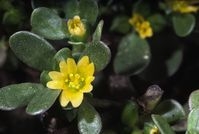
Common purslane is a summer, annual weed that thrives under warm, moist soil conditions. It has succulent stems and leaves, grows prostrate, and is a prolific seeder. Under the right conditions, fleshy stems that break away can re-root and increase infestation. Common purslane is edible and does not present any toxicity problems for livestock. There are cultural, biological, and chemical approaches to controlling common purslane. In agricultural systems, cultivation will help manage this weed when the plants are in the seedling stage, and both pre-emergence and post-emergence herbicides are effective. More information on the biology and management of common purslane is available from UC IPM.
The moisture content of common purslane stems and leaves presents a problem when it is raked into alfalfa hay and baled. With moisture in the stems, the stems are still respiring. The process of respiration produces heat. If the heat cannot dissipate, there is the potential for the hay to catch fire. Dan Putnam, UC Alfalfa and Forage Specialist, describes this in a blog post. He explains how it is critical to monitor the hay curing process and stem moisture, and he provides some guidelines for bale moisture content. This situation with common purslane is a variation on the same theme. Moisture within the bales from the purslane presents the potential for trapped heat, so it is important to control this weed, monitor bale moisture, and stack bales so that heat can dissipate.
Glyphosate tolerance, or Roundup Ready technology, is available in alfalfa. Weed control in Roundup Ready alfalfa has been reported by UC Cooperative Extension weed scientists. In stand establishment studies, Roundup controlled common purslane in the seedling stage, but efficacy was reduced on mature plants. Additionally, there is the potential for this broad-spectrum herbicide to have reduced efficacy when used repeatedly. Under conditions of repeated use, a shift in weed species populations may occur to favor weeds like common purslane.
So now, let's go back to the present situation and this PCA's consideration to control common purslane with Shark. Shark is a PPO inhibitor, also classified as a contact herbicide. These herbicides will burn leaves and stems and are most effective on broadleaf weeds. Shark was approved for use in California alfalfa in 2014 and can be used in the winter when the alfalfa is dormant or in-season between cuttings. It can also be tank-mixed with other products, like glyphosate. (Note: always consult the label before making applications.) Another herbicide of the same chemistry class, Sharpen (saflufenacil), was approved in 2016 but only for winter-dormant alfalfa. Growers should be aware, however, that contact herbicides will burn alfalfa, and the best weed control will occur on smaller weeds and with thorough coverage of the herbicide. Alfalfa regrowth could potentially be reduced in the next cutting by the equivalent of 1-2 weeks of growth, but the crop should resume regular growth, and yield should recover. See this presentation for information on weed control in established alfalfa fields.